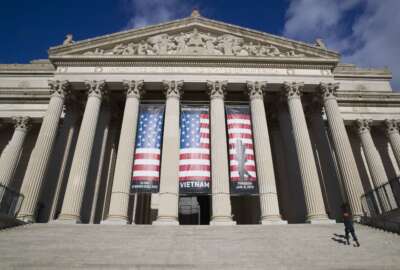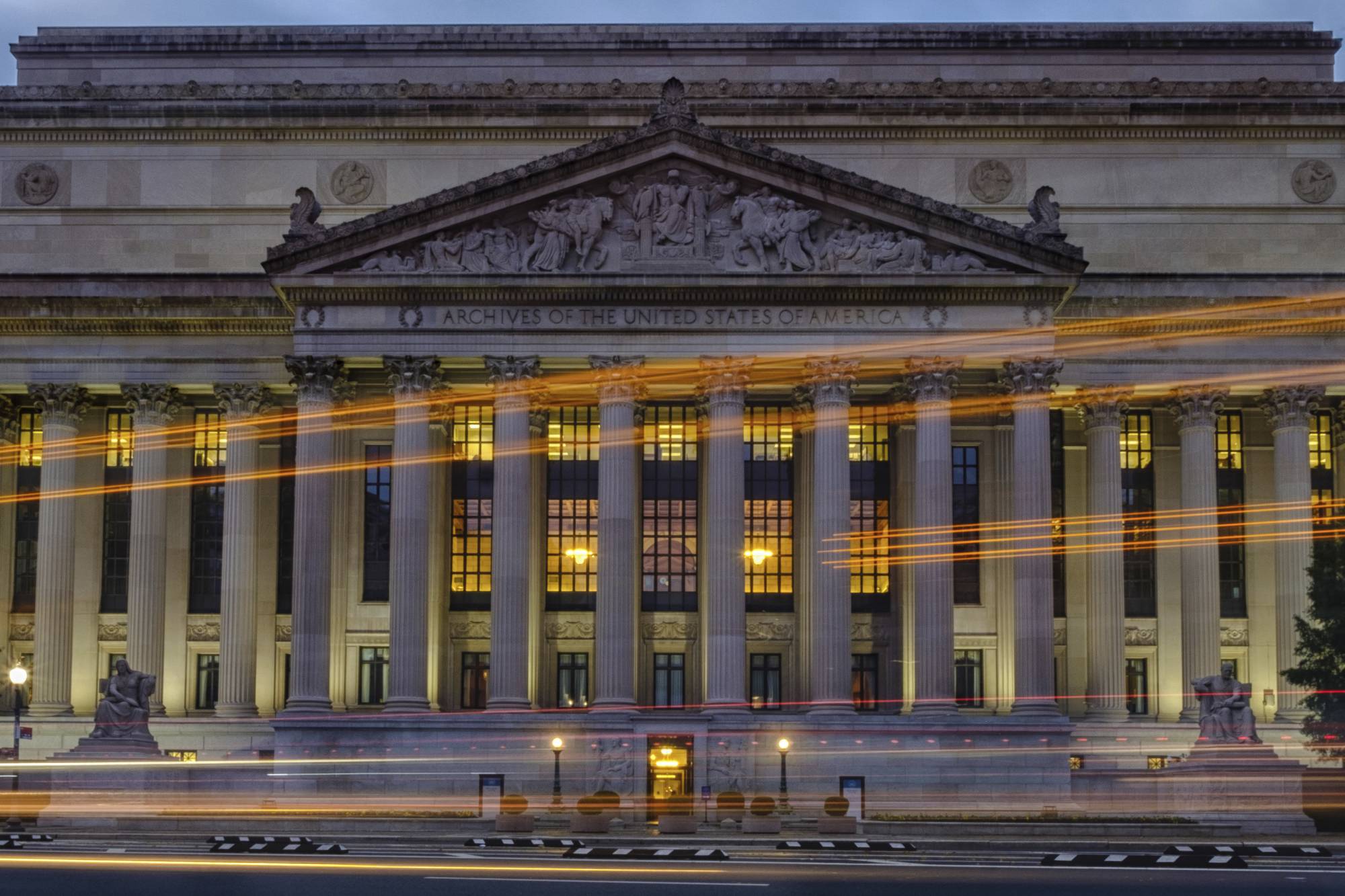A conversation with America’s 11th National Archivist and the first woman
The National Archives doesn’t hang on to every document the government generates – only the 5% or so that are deemed to have “continuing value”. But...
The National Archives doesn’t hang on to every document the government generates – only the 5% or so that are deemed to have “continuing value”. But that’s still billions of pages of text, plus all kinds of other media, from maps to electronic records. There’s a new official in charge of figuring out how to preserve and present those records to the public. Dr. Colleen Shogan was confirmed by the Senate this summer as the eleventh National Archivist of the United States, and the first woman ever to serve in that role. She spoke about her vision for NARA with Federal Drive with Tom Temin.
Interview Transcript:
Colleen Shogan Well, thank you for having me on the show. I’m actually not a historian by training, I’m a political scientist. And I came to Washington, D.C. to teach at George Mason University in the government department. And I did so for several years. And I got a fellowship with the American Political Science Association to work on Capitol Hill. And when I went to work on the Hill, I loved it so much I actually decided to stay and continued to work in the Senate for a few years. And then after that went to the Library of Congress, where I worked at the Congressional Research Service, and then became a senior executive in the Library of Congress structure. After that, I spent three and a half years at the White House Historical Association, which is the nonpartisan, nonprofit affiliated with the White House for its preservation and education. So that’s my background before coming to the National Archives in my current position.
Jared Serbu Yeah. And obviously, as part of that background, you were a consumer in many ways of NARA’s services. And I think there’s always a learning curve a bit for any new leader coming into a position like this. Maybe talk to us a bit about what you’ve learned in these few months since you’ve been on the job about what NARA is, what NARA does, all the people that you work with and lead every day.
Colleen Shogan It’s a great question. I was a user of the National Archives records predominantly through the presidential library system, but whenever you’re a researcher and you’re coming in, you’re looking oftentimes for a specific record in some cases or a specific set of records. So you have a very narrow view of what the entire system encompasses. So one of the things that I’ve been impressed by in the past five months is actually the sheer amount of records that we have. You can read about the statistics, 13.5 billion textual records in possession from the National Archives. But until you actually see that in person and you actually travel to the facilities and see the enormity of what has been accessioned by the National Archives, it’s a whole other ballgame.
Jared Serbu And as you’ve learned more and more about the agency, how has it crystallized what you want to do and what direction you want to take NARA?
Colleen Shogan I think that, I had some preferences, of course, when I was the nominee, some ideas for direction. But they’ve only been substantiated when I joined the National Archives. We will always be accessing more records because more federal records and presidential records are being created. So I think our major challenge is making sure we are as user friendly as possible. Are we providing access to Americans in the best way we can under the law? And that reflects both our in-person experiences here, for example, where I’m talking to you today in Washington, D.C. at our headquarter location, where we have the founding documents on display. We have many visitors and tourists that come to see us on a daily basis, our researchers that come in to our archival facilities here in Washington, D.C., in College Park, Maryland, but across the United States. And also are online users, because we now that know that not everybody can visit us in person. So how about that digital experience to doing research and learning about our nation’s shared history.
Jared Serbu And as you think about increasing that accessibility to more people, is that primarily digital? Is that where the whole ballgame is really at this point?
Colleen Shogan For a numbers perspective, I think if you wanted to really increase the number of users of the records, then yes, digital is going to be the way that you’re going to be able to do that, because then you’re not limited by proximity in any way, not even limited to American citizens. You’re really reaching everybody in the world. So we do want to focus on that. But also we’re very cognizant of the fact that we have an important anniversary coming up in 2026, the 250th anniversary of the United States. And that we will be welcoming, I’m sure, record numbers of people in person to see our founding documents. Here in Washington, D.C., and then our other documents all across the United States. So we also want to make sure we are providing quality in person experiences as well.
Jared Serbu And I know the agency has been in the process of a really massive digitization move, moving federal agencies really to digital processes as the way that you get your assertions from them. I don’t know if you could share anything about how that’s going, but maybe at least talk a bit about the importance of that and what that will change.
Colleen Shogan It’s very important. We will, in 2024, we will start to accept a permanently and only digital records on the federal side that won’t affect our presidential records accession, but our federal records, when we accept a permanent record, it will be in digital format going forward, and it’s going to be not as much of a challenge and storage capabilities because there is possibilities for digital storage. But what I always talk about is what we’re going to need to figure out is how people are going to view or view these records, how are they going to be able to search for them and how are they going to be defined for what they need. And that’s going to be the major challenge. So our user experience or customer experience in the digital format is something we’re going to have to think about. Because some people, for example, like me, sometimes when I’m looking, I’m looking for an a precise record or a precise photo, something that will actually meet my needs as a researcher. But then we have other researchers, for example, high school kids who are working on a National History Day project, and they want to learn everything they can about a particular facet of World War Two. So they’re looking for a large number of records across perhaps a period of years. So those are two different types of searches. And are we going to be able to accommodate everybody for what they need when they come to the National Archives.
Jared Serbu Is part of it reviewing materials for release ability too? Does having those in a digital format make that any easier and perhaps get them speed up the pipeline through which those things need to move so you can release them to the public?
Colleen Shogan That can be the case. And we haven’t move forward with using artificial intelligence, for example, in our FOIA searches, our Freedom of Information Act searches, yet. But that is something that we are definitely going to be working on and piloting and looking at, because as we have more digital records coming in, born digital records coming in, we know that will exponentially increase the number of records in our possession just by the sheer nature of digital versus analog. And the only way that we will be able to provide access to people, particularly through the FOIA process, will be using some version of artificial intelligence to help us narrow those searches.
Jared Serbu All right. Well, before we run out of time here and any other big priorities that we haven’t talked about yet?
Colleen Shogan Well, when I came on board, I did make the announcement that we would be including the Emancipation Proclamation as one of our founding documents inside the Rotunda here in Washington, D.C. And we are looking forward to gaining support to be able to do that. Building a case that will preserve the Emancipation Proclamation so that many generations to come when they visit Washington, D.C., will be able to view that document alongside the declaration, the Constitution and the Bill of Rights.
Jared Serbu It’s really interesting. What are the main obstacles to actually pulling that off as of now?
Colleen Shogan Well, we have our preservation and conservation specialists that are continuing to do testing. We think we have selected the right type of case, the right type of technology that can help preserve the Emancipation Proclamation. So now the challenge after that will be making sure that we’re able to have the funds, private or public, to be able to build that case so it can be included in the rotunda.
Copyright © 2025 Federal News Network. All rights reserved. This website is not intended for users located within the European Economic Area.
Tom Temin is host of the Federal Drive and has been providing insight on federal technology and management issues for more than 30 years.
Follow @tteminWFED






